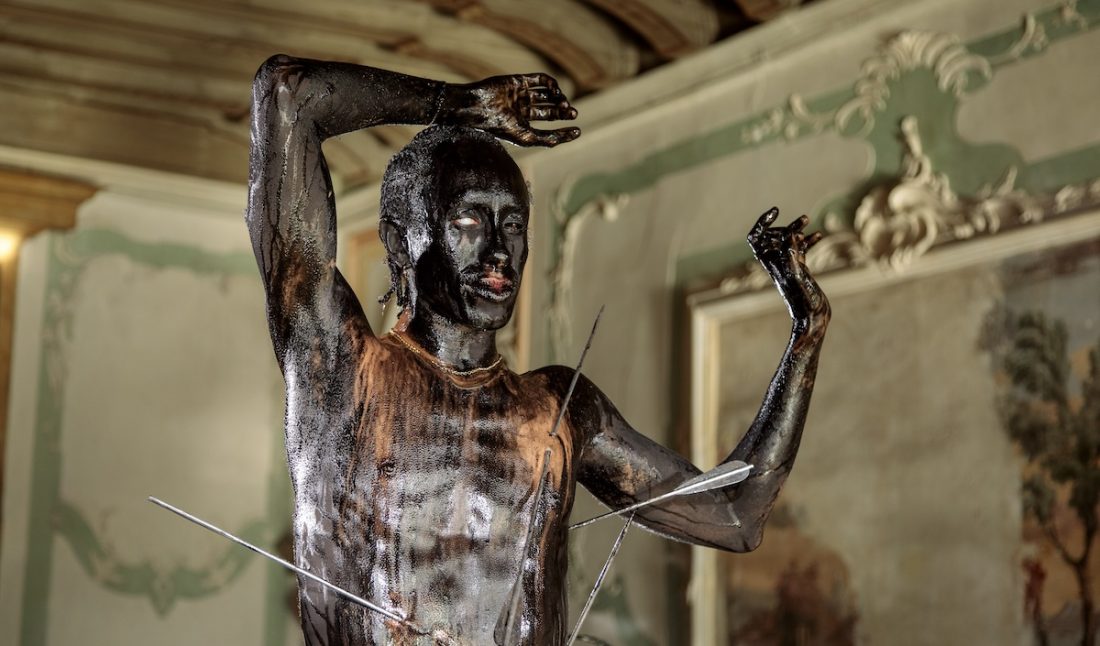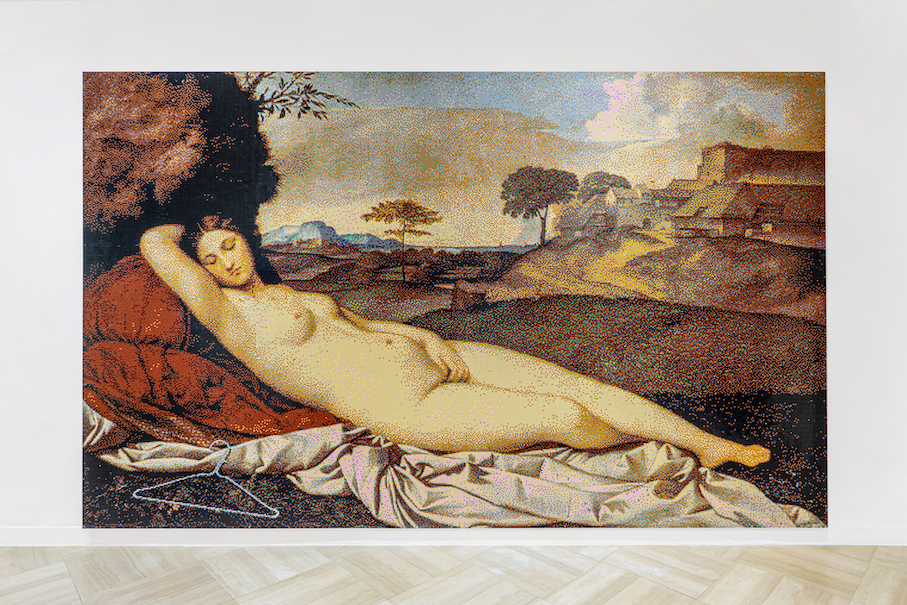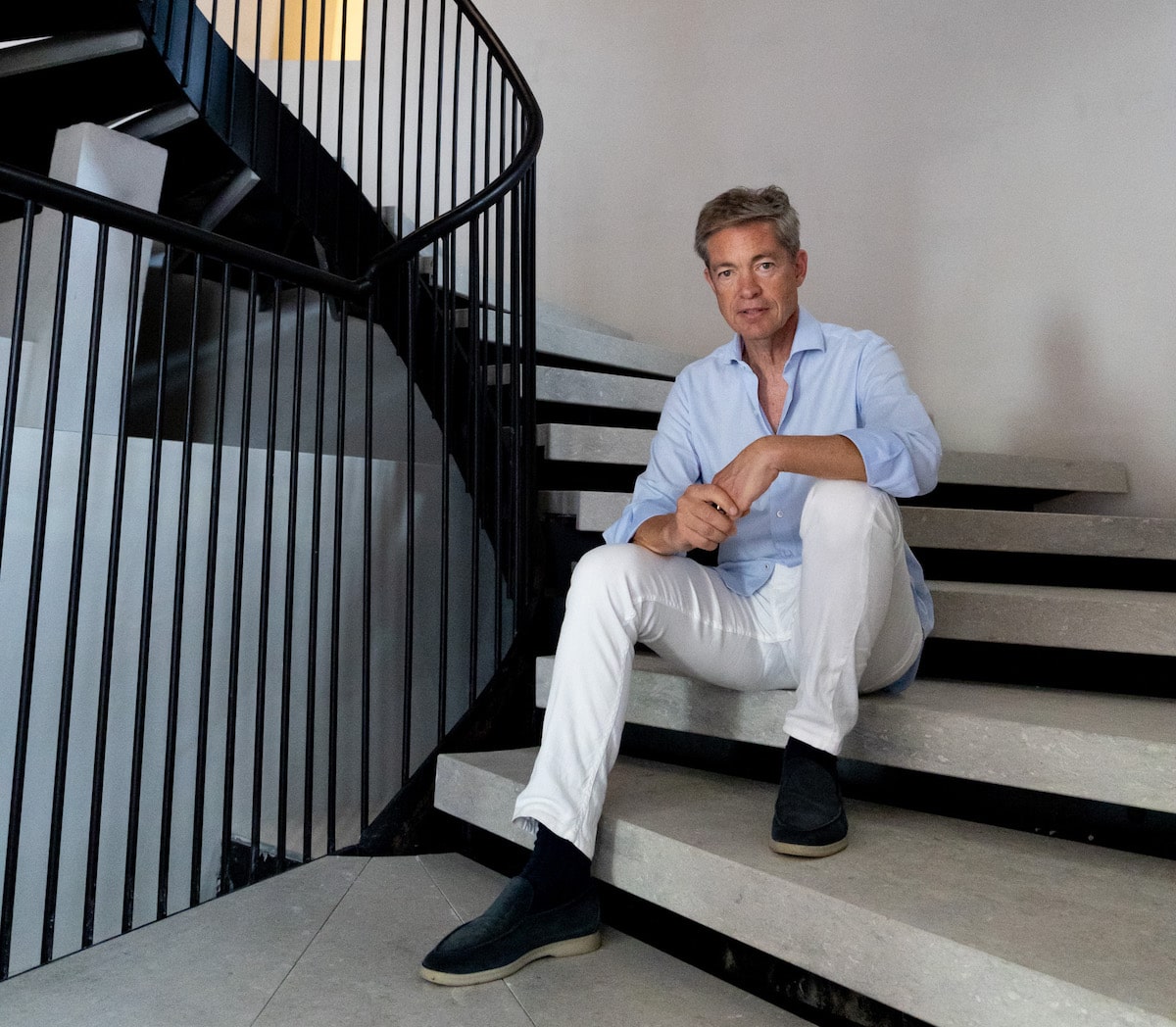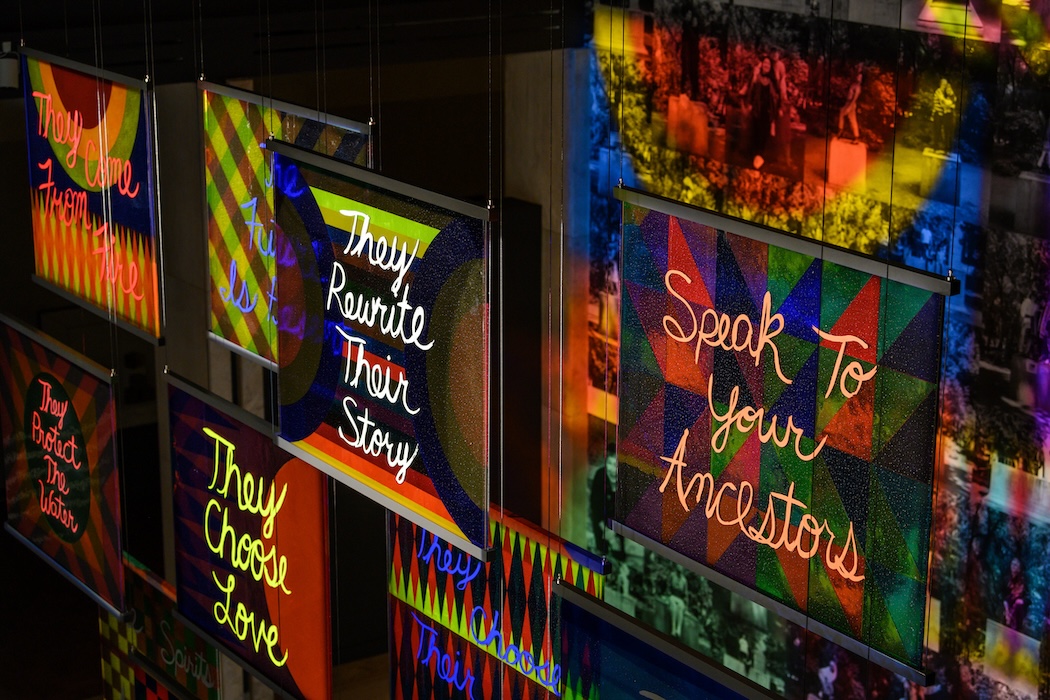Sun poured in through the near floor-to-ceiling windows of the Palazzo Malipiero in Venice, bouncing off five mirrored platforms, the glistening painted body of Miles Greenberg, and the five silver arrows that pierced his skin. For eight hours, as the light of the day changed, casting shadows on the room’s storied, frescoed walls, Greenberg stood atop a stone, the black paint on his skin slowly smudged off by the drip of sugar syrup that dripped from the ceiling, down his body, to pool at his toes. Spinning at 1 rpm, his body took on the position of Saint Sebastian, the Christian saint and martyr depicted over and over again by artists. At the end of the performance, Greenberg’s mother was there to remove each arrow.
Greenberg has visited every iteration of the Venice Biennale since he was in utero. His mother was in theater when he was a child and he grew up around and in the arts. He was just 26 years old this year when his Sebastian was held during the opening week of the mega art event, curated by Klaus Biesenbach and Lisa Botti, presented by Neue Nationalgalerie and Museum Berggruen in partnership with Gallerie dell’Accademia.
The Canadian-born, New York–based artist, as the story goes, saw Marina Abramović’s The Artist Is Present at MoMA, and he knew he wanted to be a performance artist. Later training with Abramović, Édouard Lock, and Robert Wilson, he has since gone on to exhibit at the New Museum, the Louvre, and the Neue Nationalgalerie, as well as participating in the Athens Biennale, BoCA Lisbon, and the Bangkok Art Biennale. His practice encompasses durational performance, sculptures, installation, and film, investigating the body as material and engaging the audience’s multiple senses—evoking sights, smells, sounds.
Miles Greenberg Performs “Sebastian” During the Venice Biennale Opening Week
Greenberg’s Sebastian in Venice was in direct conversation with Gallerie dell’Accademia’s images of Saint Sebastian at the threshold of agony and ecstasy, as well as moretti, the blackamoors found all over Venice, depicting anonymous Black figures found on door handles, table and chair legs, vases.
The artist’s performance in Venice was one of the most talked-about things of the biennale’s opening week. Whitewall reached out to Greenberg to learn more about it. He shared with us photographs of the breathtaking performance taken by Viðar Logi—one of which you’ll see on our cover—and suggested a conversation with Jordan Tannahill, the novelist (Liminal, The Listeners), playwright, and director who was not only present in Venice but will collaborate with Greenberg on a text accompanying a day-long performance at the Art Gallery of Ontario on June 5, entitled RESPAWN.
Greenberg and Tannahill discussed Sebastian’s beginnings, from an early test at the Louvre to its powerful presentation at Palazzo Malipiero.
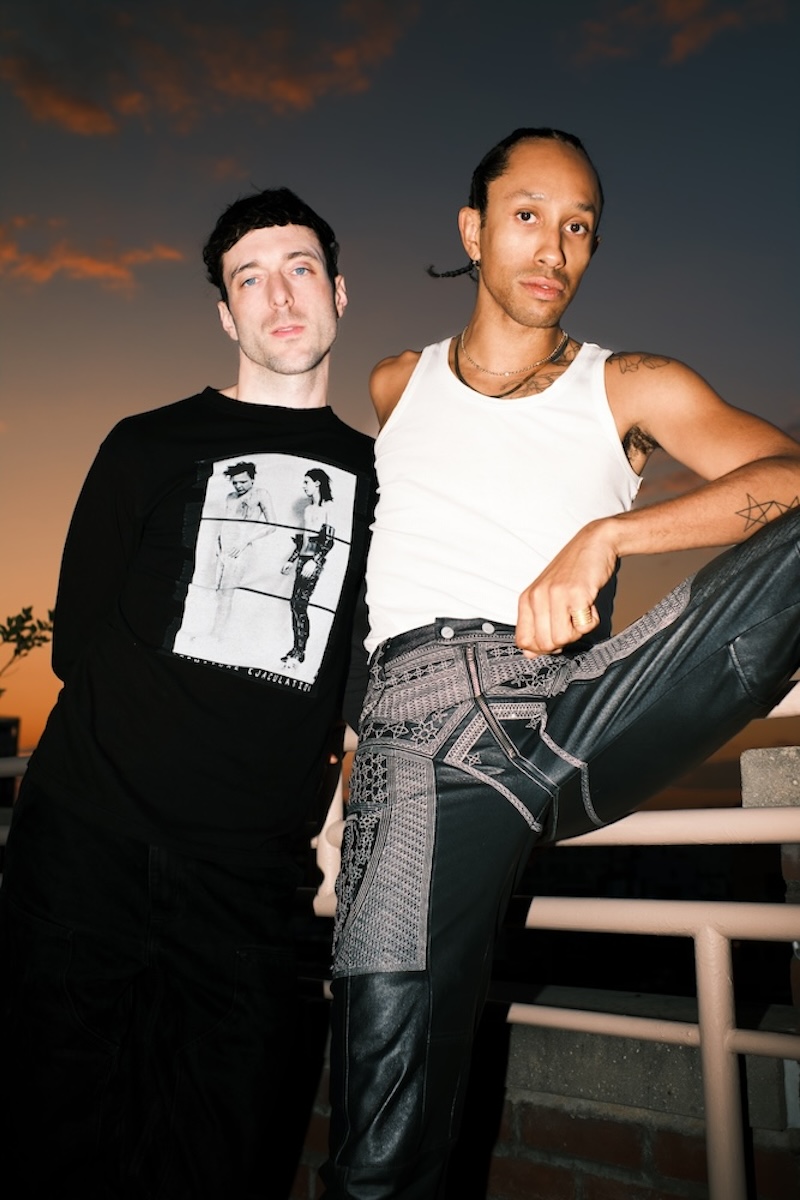 Portrait of Jordan Tannahill and Miles Greenberg by Viðar Logi.
Portrait of Jordan Tannahill and Miles Greenberg by Viðar Logi.
JORDAN TANNAHILL: When did the conceptualization of Sebastian begin? Of course, a version of the performance first happened at the Louvre, and then you have the tattoo. I feel like the iconography of Sebastian has been something you’ve been living with for years almost at this point.
MILES GREENBERG: I don’t really remember where this obsession with Sebastian started for me, but I have a sketch dated 2021 where I drew this work exactly as we did it in Venice, more or less.
I was, at the time, looking at a lot of studies by Géricault and Delacroix. They would draw and sketch and paint the same horse’s hoof in nine thousand different positions over and over and over again just to get it right before they actually put oil to canvas.
And so for me, when I got the Louvre opportunity, I figured it would be a good place and time to do a test. I’d never done that before.
I’m constantly looking for ways in which performance and my performance practice in particular can align with art history as opposed to what I think it often is relegated to, which is something parallel to our history. Looking back and then applying those trajectories through my own lens has always been a strategy for me. I think especially coming from no academic background and starting very young, it’s been a strategy for being taken seriously more than anything.
And I think, yeah, obviously it’s something that’s been reprised. It’s a character that’s been reprised through many, many queer lenses, many an alternative lens. He’s been an icon, I think, to a lot of the freaks. I wanted to do it. I guess I just wanted to make sure that the real essence of it was on a level that could be seen as comparable as I could get to the old guys.
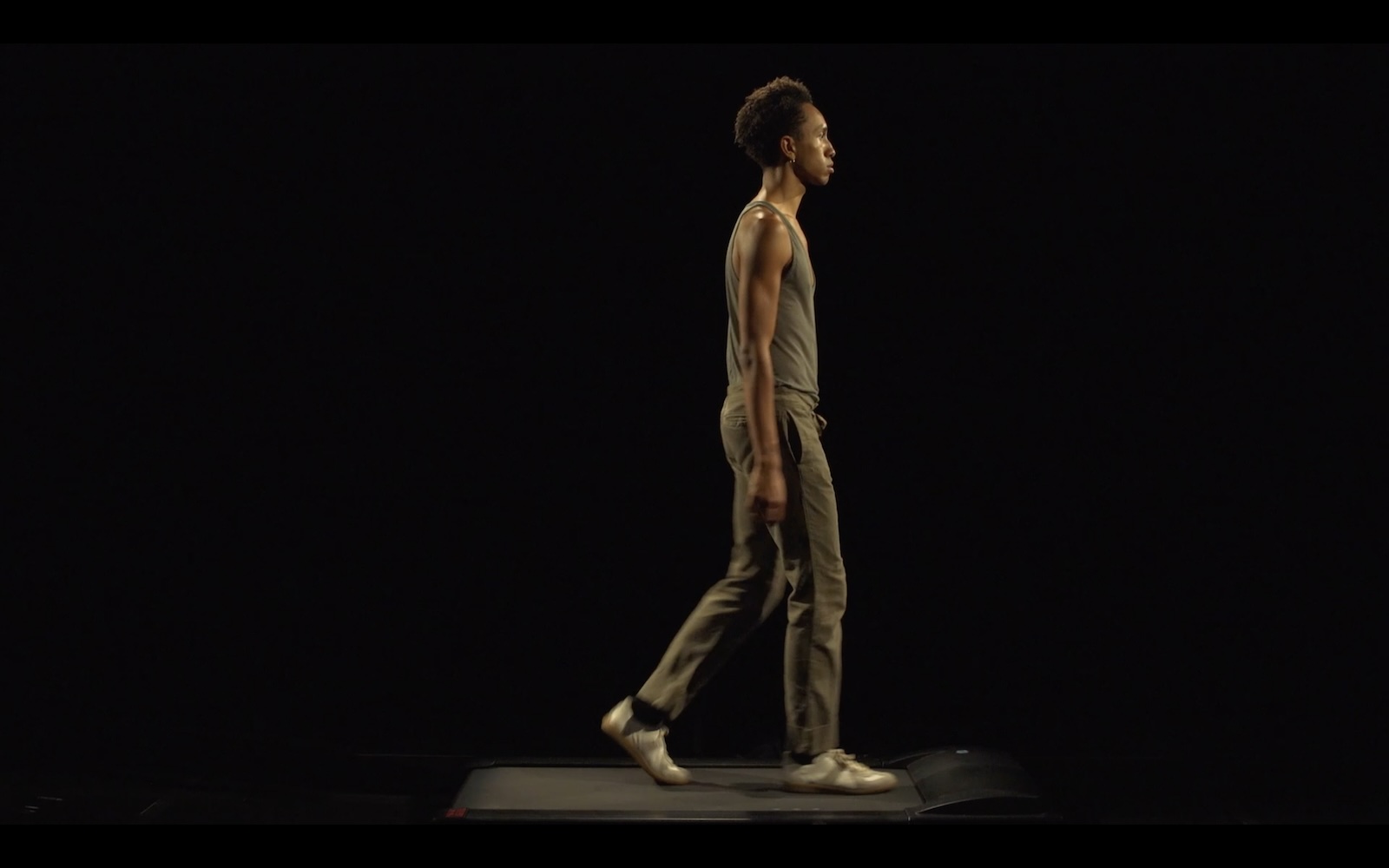 Miles Greenberg, “Oysterknife,” 2020, presented online through the Marina Abramović Institute
and shot at Centre Phi, Montreal, Canada, courtesy of the artist.
Miles Greenberg, “Oysterknife,” 2020, presented online through the Marina Abramović Institute
and shot at Centre Phi, Montreal, Canada, courtesy of the artist.
“I’m constantly looking for ways in which performance and my performance practice in particular can align with art history,”
—Miles Greenberg
JT: Speaking of 2021, I’m trying to figure out when we met. And I feel like—
MG: I feel like it was at Jeremy’s house.
JT: It was 2021.
MG: Was it?
JT: It was November 27th, 2021.
MG: Okay. So let me actually find out where the sketch . . . Because I have it dated because I scanned it.
JT: Yeah. I was in town staying with Jeremy O. Harris, and this was just around the time that he, I think, produced a workshop of my play.
MG: There it is, November 28th, 2021.
JT: Oh my God. Amazing. Wow. Literally the day after we met.
MG: [Gasps] Weird!
JT: And here we are years later. You’ve performed two versions now, at the Louvre and during the biennale in Venice.
MG: I was so lucky to have you there for that. For context, you and I and Viðar and Arvand all bunked in this gay little Palazzetto for ten-ish days. And it was the best little roomie situation.
JT: We really held down the . . . Was it Campo?
MG: Campo Sant’Angelo.
JT: Sant’Angelo, that was it.
MG: Angelo’s rolling in his grave.
JT: Yeah. That was an incredible week. It was really a thrill to get the whole BTS of it, waking up on the day of, and having your mom come over, and seeing the film crew arrive, and the paint job begin, and that incredible Cerruti overcoat that you wore from the walk to the actual palazzo where the performance occurred.
MG: Palazzo Malipiero.
JT: Yes. Palazzo Malipiero. And then to be there to witness the arrows going in and the extraordinary precision of that process. I was so astounded by the way in which you were still so conversant with everyone around you, and aware, checking in on other people’s needs while you were literally being pierced with arrows. You were just so . . . You remained ever the convener of all these people around you, family, friends, collaborators, right up to the moment that you stepped on that rock.
MG: Thank you. Well, first and foremost, it hurt about a quarter as much as it did at the Louvre because we spent more on the needles. And I just want to put this in print for anybody who’s going to be using needles. Spend your money on the needles.
JT: Needles, right.
MG: I was like, “Oh, wow. That’s nicer.”
JT: Wow.
MG: Like butter! But no, I was so excited to have you there because also, I don’t think I told you, but I was reading Liminal, one of my favorite books of yours, in my residency in Miami where I was fleshing out the idea for Sebastian.
It was just after I’d done the Louvre and was trying to find a home for the new one, which came organically through Klaus Biesenbach, Lisa Botti, and Museum Berggruen and the Neue Nationalgalerie for this Venice convening.
But having your voice and gaze on it was so completing to the process for me—you were somehow very much in the DNA of the piece already, just given that I was engaging with your work throughout.
And then, of course, we have this upcoming collaboration together where you wrote a piece for this performance that I’m doing at the AGO in our mutual home country, which I’ll get to because it’s unbelievably potent.
Obviously, you openly engage in various kink and BDSM cultures and are also very knowledgeable about that world. This particular arrow technique, I was educated around it through people who do play piercing as a fetish, and also artists like Ron Athey and Franko B, who come from sort of an older school of kind of body art.
What’s your take on integrating those fundamental elements of something that has perhaps otherwise been more a part of a lifestyle versus putting it into an art context?
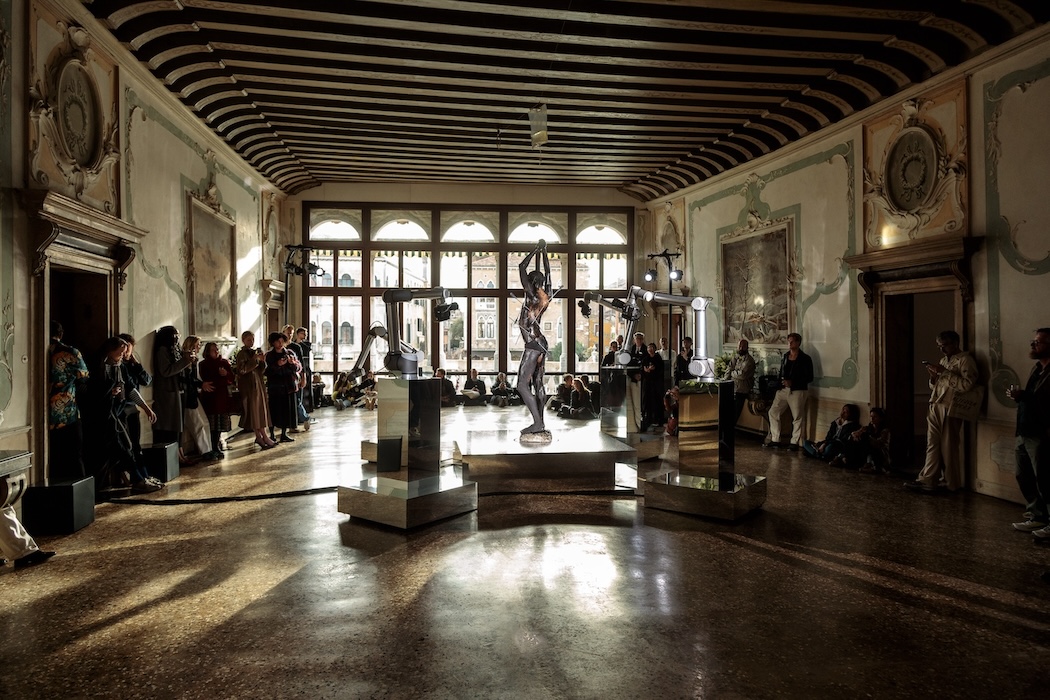 Miles Greenberg, “Sebastian,” 2024, Palazzo Malipiero, Venice, Italy,
photo by Francesco Allegretto, courtesy of the artist, Museum Berggruen and Neue Nationalgalerie.
Miles Greenberg, “Sebastian,” 2024, Palazzo Malipiero, Venice, Italy,
photo by Francesco Allegretto, courtesy of the artist, Museum Berggruen and Neue Nationalgalerie.
“I was reading Liminal, one of my favorite books of yours, in my residency in Miami where I was fleshing out the idea for Sebastian,”
—Miles Greenberg
JT: It’s true. I really do see Sebastian in that legacy of work interfacing on some level with—
MG: Faggotry?
JT: Yeah, faggotry, for sure, and also fetish iconography, on some level. I mean, obviously, it’s working on so many other different levels as well.
I’ll answer that by way of going back a little bit to what you were saying about reading Liminal—the figure of the mother is so strong in Sebastian, especially at the end. Your mother quite literally comes out and removes these arrows from your body, which is so affecting. Liminal is very much about my mom in a liminal state, the uncertainty as to whether she’s alive or dead. Ultimately, it’s very much exploring mother/son relationship, but also what it is really about is abjection. It draws a lot on the writing of Julia Kristeva and this kind of breakdown between body and object, which really forms the textual basis of RESPAWN.
I think Kristeva is one of our early points of shared reference. I saw Powers of Horror on your desk when I first came over to your studio in Chinatown. It’s exciting now these whatever couple years later to be collaborating together on RESPAWN at the AGO, which is I think so much that ontological breakdown between body and object where you are literally surrounded by this corpse field of yourself. There are all these extraordinary Kristevian layers to this performance, and the text tries to capture that. I’ve really been so inspired by what you’ve been doing. It was really lovely to write the text for RESPAWN as a tribute to you in a way—a tribute, and a kind of portrait.
MG: Wow. You’re making me emotional!
Miles Greenberg Investigates Personhood Versus Objecthood in Performance
JT: With regards to the question of fetish, for me I think one of the ways in which I think about hard play—which might be fisting, or might be BDSM pup play, sub/master relationships, and even drone play to some extent—as kind of erasing one’s personhood and becoming a sex toy or whatever else the case might be. For me, the interest is in a kind of rendering of the body into an object or the sort of breakdown of the divide between the two, and the eroticism of that.
Also, something we have talked a lot about is the Georges Bataille “limit experience,” the body pushed to the very brink of its being. I feel like that state of the ecstatic intolerable is something that could occur in sex, but I think I also see you existing within that space within Sebastian and other performances of yours. I’m curious about that. What’s that like to occupy that space? Do you feel like you’re occupying that space in those performances?
MG: That’s a really, really, really beautiful reading of it. I’ve never been able to quite put it into those words, but I think you’re absolutely right. I think there’s a level to which all the performances have that very profound commonality with sex. I think there is a level of depersonalization that is at once so much more personal, I think, than the egos we portray, or our identities, or who we think we are in the streets. It’s about putting on one mask to remove another.
At the end of a performance, I always make contact with that threshold of personhood versus objecthood. Maybe I’m just being a huge Scorpio here, but for me, that’s a place where you will always find an incredible secret, and you know you can never take it back with you to the real world. That’s how I think of it, anyway. That, to me, is the essence of what kink and BDSM and fetish culture ultimately are chasing. It’s sort of that point of a physical, physiological, or emotional or intellectual experience that is so visceral and so completely removed from real life that you learn something that you feel in your body.
It’s like a knowledge that’s somehow very corporal or very kind of liquid and slippery. Then, when you come back, when you come to, you lose it again, it escapes you. That’s what I find every time I finish a performance. Maybe the last quarter, the last fifth, the last 10 seconds I’ll be like, “Ah, yes, this is what it was all for. This is what it IS.” I’ll find God. There’s no other way to put it than having contact with the divine.
Then, you come off of it and within a few hours, you simply forget. You have a memory of it like a dream, but you are touching a secret that you have to leave behind, like being in an archive room in a library.
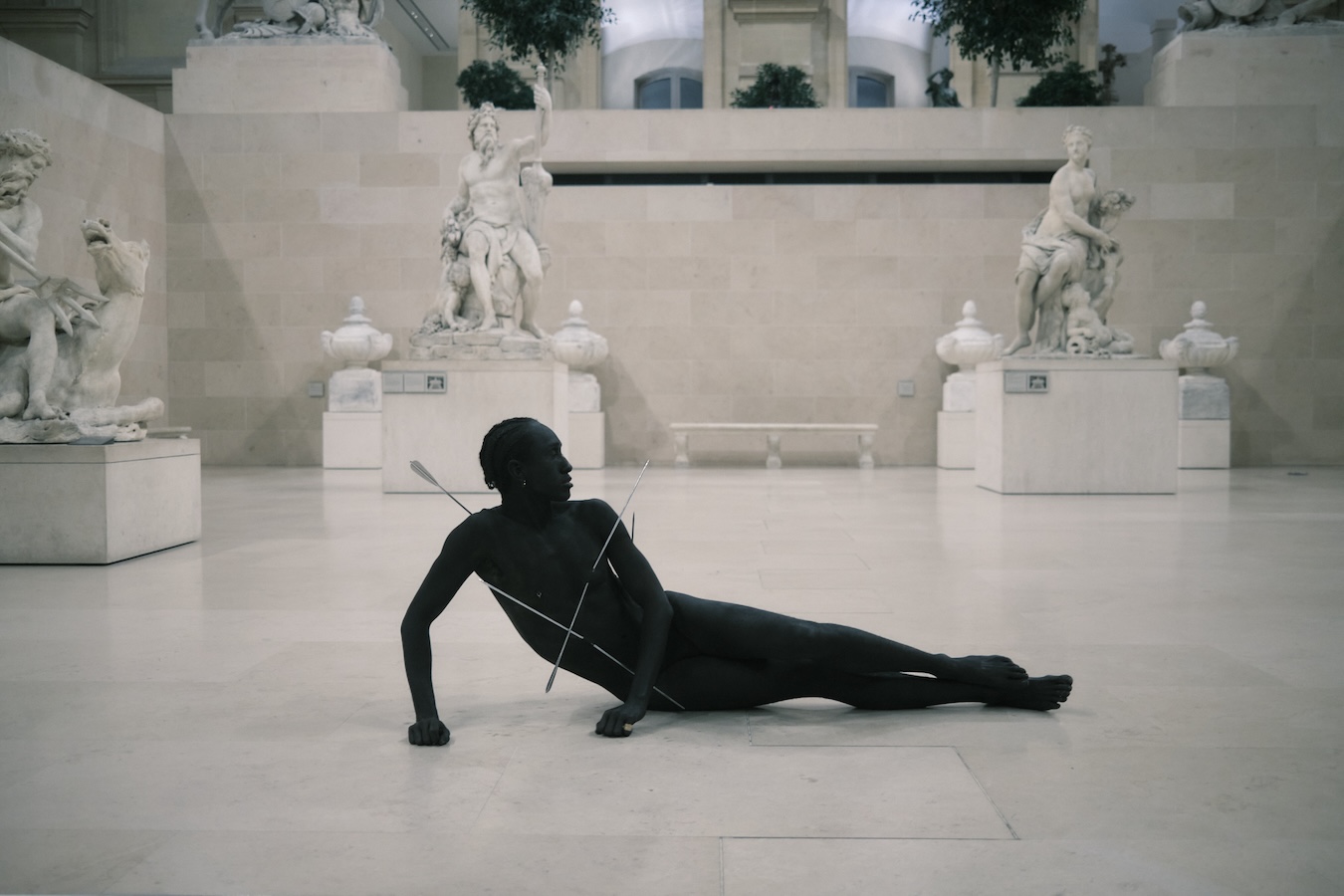 Miles Greenberg, “Etude pour Sébastien,” 2023, Le Musée du Louvre, Paris, France, photo by Viðar Logi, courtesy of the artist.
Miles Greenberg, “Etude pour Sébastien,” 2023, Le Musée du Louvre, Paris, France, photo by Viðar Logi, courtesy of the artist.
JT: And something that you said made me think as well about ritual as a gateway to total vulnerability and intimacy. And that’s something that I feel like BDSM and your performance share. I think that’s what’s so fascinating to me when you’re talking about the paradox of masking and unmasking. The paradox of creating this kind of elaborate ritual, with this kind of extraordinary scenography and makeup and this whole frame that is highly aestheticized, highly ritualized, but all of this for me is an aid of ultimately actually accessing this point of total vulnerability, this intimate access to you, but especially by the end of the performance, I feel like you’re just this denuded pulp of the throbbing essence of yourself.
MG: Absolutely.
Creating Total Vulnerability in Performance
JT: And so that’s this extraordinary paradox of all this ritual that goes into stripping away, not about keeping oneself at bay, but in fact, creating a total intimacy with the spectator. And that, for me, is so much what BDSM is. You have this highly ritualized space of hoods and whips and names and codes of conduct and play spaces and fetish gear and costume, et cetera. All of which is about creating total vulnerability.
MG: I love that. And what else shares that with performance art and BDSM is Vodou, and a lot of Afro-Caribbean spiritual practices, really follow those same sort of models of ritual to create total intimacy—which is often projected on some external divination—but if you think about it, it’s often channeled through the bodies of the people performing those rituals. So really it has to do with intimacy with the bodies of the people involved as well, I think. So learning about those practices in the time I spent in Haiti was one of the biggest reference points that I ever had going into my own performance practice. And I definitely feel that there’s many links between that and the worlds that we’re also talking about.
It all feels very fundamentally human. There is an extraordinary human tendency to want to reach intimacy through these codes, symbols, and transitory objects that bring us into a specific headspace where we open up; it’s sort of typing in a code to a safe, but it might be a chain and a whip, or an incense or a libation, this plus that equals an altered state purely through psychology and the spirit that trigger something greater in the body—a rush of blood, dilated pupils, moaning and speaking in tongues . . . I guess that those are sort of the symbols that I’m trying to invent anew in my own universe. This is what a camera means, this is what a mirror means, this is what the texture of sugar syrup or black paint or darkness and light means to me. Hopefully, if something means a certain thing to me, it will to my audience, too.
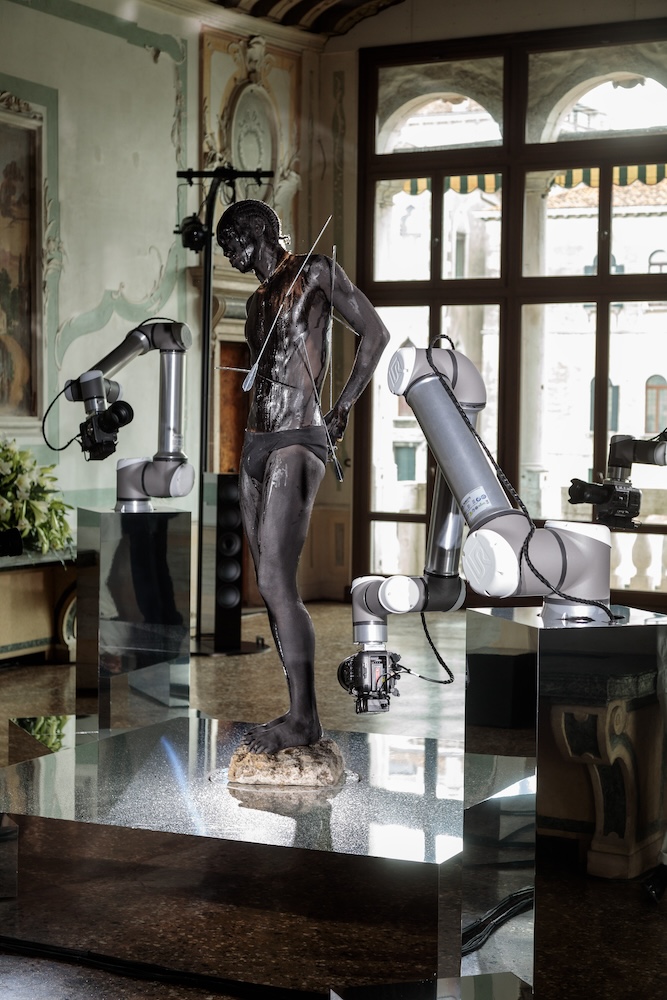 Miles Greenberg, “Sebastian,” 2024, Palazzo Malipiero, Venice, Italy, photo by Francesco Allegretto, courtesy
of the artist, Museum Berggruen and Neue Nationalgalerie.
Miles Greenberg, “Sebastian,” 2024, Palazzo Malipiero, Venice, Italy, photo by Francesco Allegretto, courtesy
of the artist, Museum Berggruen and Neue Nationalgalerie.
JT: It’s interesting too, the very word “fetish” of course comes from these ritual objects, these fetishes from Vodun. And I think about the sculptural works that you make from your performances. They’re modeled after these 3D scans of yourself, which are in a sense kind of these fetishes or captures of the ritual themselves that kind of live on independently—they’re akin in some ways to the fetish of the ritual. I’m curious about what kind of spiritual relationship you have with those sculptures? Or to what extent do you feel them imbued with the essence of the performance that made them? How do those live on and what is your relationship with them afterward?
MG: I definitely still feel the moment in them. Usually, they’re captured towards the end of a performance, so you actually see a lot of the cracks. The end of the performance, it’s always where the flesh and the material and anything around it has sort of deteriorated. The paint has worn off, the body has grown weak. There’s all these flaws, there’s these material glitches as well as these digital glitches, the whole thing feels very organic.
But I remember the feeling. I think if you see a photo of yourself injured or just as something peeling off of you or something falling off of you, you still feel the feeling in your skin somehow. So definitely when I look at them, I definitely know. I think they’ve successfully captured time, at least for me in the first person.
JT: That’s really interesting.
MG: The urethane and steel sculptures that I’ve made up until now, I love them and I love making them, it’s a very agreeable material, but what I’m working on next has me really excited—I’ve recently started sculpting in marble. It’s my first time using an organic material. It lives and breathes, it changes, it deteriorates, it’s unpredictable. My biggest fascination with performance is the ways in which it deteriorates. The duration allows you to really sort of see a form be born, live, and then die. Like, stone changes shape over seven hundred years, a body will change shape over seven hours. A lot of the research behind my performance practice was around classical sculpture, and how at every stage of a sculpture’s life cycle, it is seen as complete—Venus de Milo has no arms. You don’t picture her with arms. You don’t throw her away. You take her as complete, there at that moment. And she’s performing and she’s going to lose her head and her tits and her skirt and everything. It’ll all be dust. So I kind of think the performances do the same thing, just very accelerated.
African sculpture in general is very often functional. A big feature of a lot of African sculpture, particularly West African, is that when used in ritual, in order to honor the ancestors that they represent or otherwise keep the object alive, you need to continue to nourish the object with libations, or oils, or other substances. They’re not made to just sit behind glass, otherwise they kind of die. It’s like certain ancient Chinese teapots that are in museums. They actually need to be utilized every so often by conservators in order to keep the clay from just turning to dust. So someday, my dream is to create something truly alive like that—things that really need human touch to stay animate. And then I’ll kind of feel like I will have actually put a spirit into something fully. I kind of want to get there by the time I’m, like, 80.
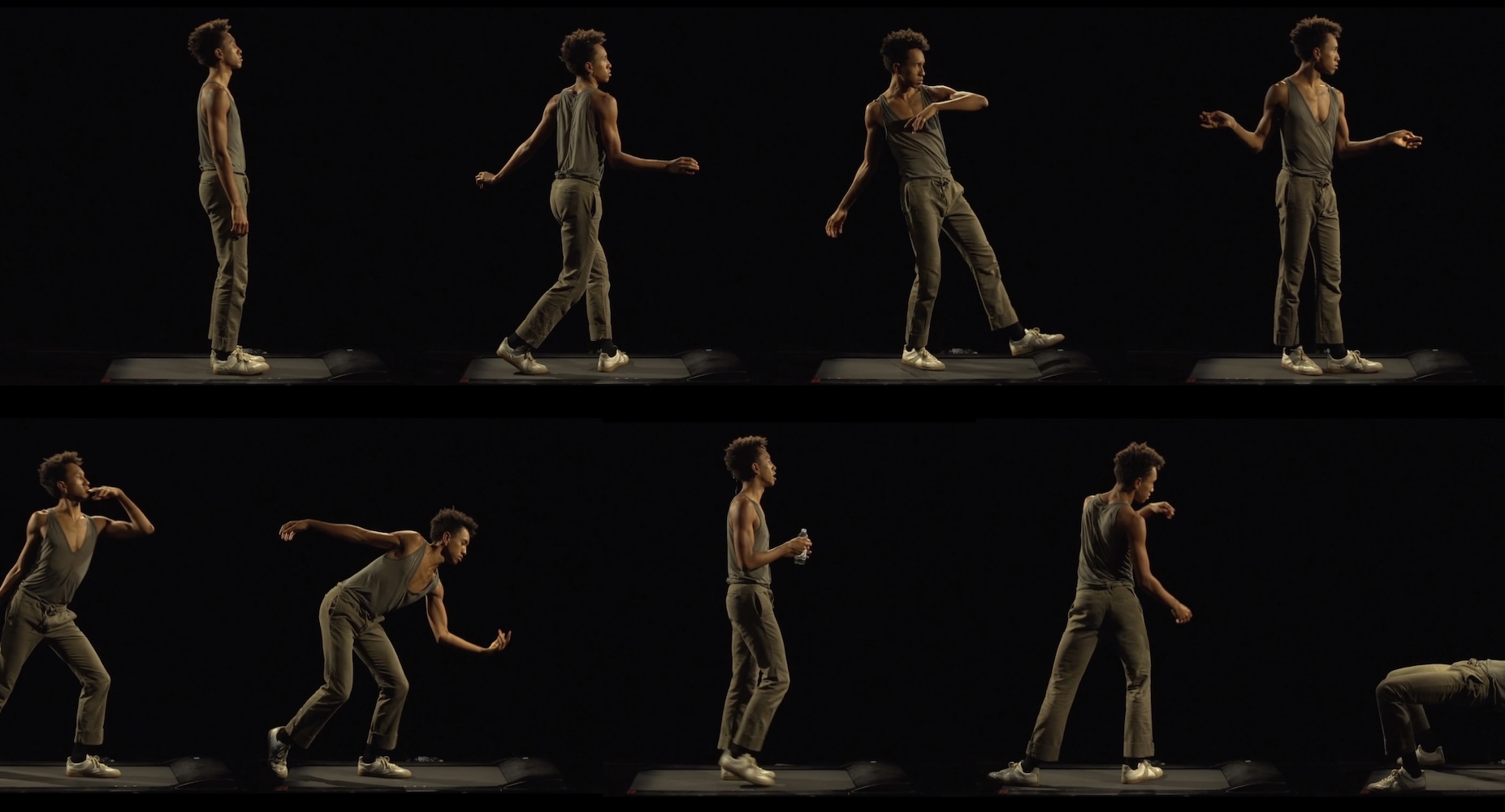 Miles Greenberg, “Oysterknife,” 2020, presented online through the Marina Abramović Institute
and shot at Centre Phi, Montreal, Canada, courtesy of the artist.
Miles Greenberg, “Oysterknife,” 2020, presented online through the Marina Abramović Institute
and shot at Centre Phi, Montreal, Canada, courtesy of the artist.
JT: Yeah, yeah, you will.
MG: That’s sort of the plan with the sculptures, because like I’m aware that I have a ballerina life span with the shit that I’m doing now. I mean, I will be performing for a while, but even Oysterknife, this 24-hour piece that I did in 2020, I was 22. I couldn’t do that now at 26.
JT: Do you think so?
MG: No, I don’t think I could.
JT: Yeah. Speaking of these feats of endurance and of sometimes feeling like, for a moment, that you’re almost proximate to the divine, whatever that might be. I think about Sebastian, I think about some of the early Christian iconography that you’ve interfaced with, and I think about how when you read about the lives of the early saints, I’m like, “Girl, these are performance artists.” Simeon Stylites standing on this pillar, or Saint Agatha cutting off her breasts, or so-and-so is standing in a frigid creek for 40 hours or whatever. It’s like these are gestures of performance art. And what I guess I’m curious about . . . yeah, just first of all, this human impulse to push oneself in these physical ways to reach this place of divine intimacy through duration, exhaustion, bodily atrophy. I guess, where do you see yourself in conversation with that?
MG: I do love that perspective, but I’m not sure if I feel like I can quite position myself quite in that way. I’m not a person and I’m not going in with some saintly aspirations, I’m definitely an object when I’m onstage, and happily so. I have my interiority when I’m up there, but as far as the audience sees me, it should be the shape of a person, rather than an actual person.
JT: Yeah, yeah, yeah.
MG: I’m always kind of in NPC mode in shows.
JT: I feel like you’re kind of drawing on a few things with RESPAWN. That’s certainly one of them. Gaming as sort of iconography.
MG: Well, yeah. It’s a lot of the same sort of characters, I would say. I was far more familiar with video game characters early on than I was these Christian icons. I grew up Jewish, very reform, so when I learned about Saint Sebastian, it was way later, they weren’t ubiquitous in my life.
JT: Yeah.
MG: Zelda is much more sacred.
JT: [Laughs.]
MG: These symbols that allow us to become and unbecome. The truth is, it’s so easy for me to talk about Sebastian now. It’s really hard for me to talk about RESPAWN today because I find it impossible to adequately discuss a performance before it happens because I haven’t made it yet, not really. I don’t know what the fuck it’s about until it happens. I mean, I think that, I’m sure you must feel that sometimes when you’re writing.
“I find it impossible to adequately discuss a performance before it happens,”
—Miles Greenberg
JT: Yeah. Also, it feels like even the line between where one performance begins and ends, I feel like everything is in conversation with itself, maybe at the moment or always within your work, where it’s like, it’s just this kind of torrent of ideas and energies, and the same creative forces move you and it becomes RESPAWN, and a moment later it could be almost something totally different.
MG: Let me cut you short there, because I don’t know if I’m ready to hear about the through line—I’d rather read about that when I’m done!
JT: Yeah, yeah.
MG: That’s something that I’m like, I think at the end of it all, I’ll look back. I think if I look too much at an overarching narrative, I’m going to get ahead of myself, and I have no interest in predicting the future. I just try to be very, very, very current with what I’m feeling.
I kind of take a peek sometimes and I’m like, “Ooh, yeah, that is a sequence. There is a through line. There is a narrative. There’s a continuity that’s starting to play out.” But it’s my biography and I don’t want to read it before it’s done.
JT: Yeah, yeah. Totally.
MG: So, let’s pick this up when I retire, maybe.
JT: I don’t think you’ll ever retire.
MG: I don’t think you’ll ever retire.
Thank you, Jordan.
JT: Thank you.
MG: I love you.
JT: I love you, too.
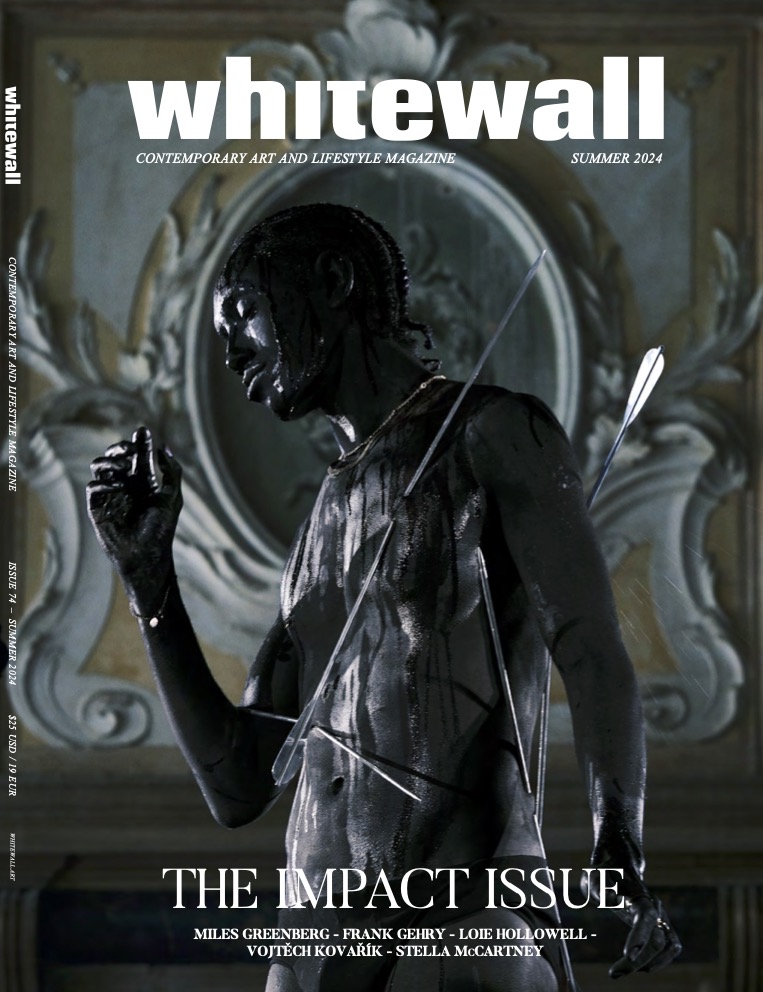 Whitewall’s Summer 2024 Impact Issue Cover featuring Miles Greenberg, photographed by Viðar Logi.
Whitewall’s Summer 2024 Impact Issue Cover featuring Miles Greenberg, photographed by Viðar Logi.







